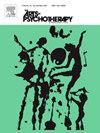Visual narratives as evidence: Surveying the role of metaphors in art therapy
IF 1.5
3区 心理学
Q3 PSYCHOLOGY, CLINICAL
引用次数: 0
Abstract
Metaphors are integral to communication, processing information and therapeutic insights transferring meaning between domains and fostering understanding. Rooted in linguistic and sensory processes, metaphors function as semiotic signs bridging abstract and concrete concepts. In art therapy, they enable non-verbal expression, narrative construction, and emotional exploration, offering insights into clients’ internal worlds. Studying the use of metaphors as evidence in art therapy is one of six categories identified as an outcome of a well-researched project formulating an Art Therapy Research Strategic Plan. Consequently, this study represents a preliminary exploration of the feasibility of metaphors as therapeutic evidence, focusing on their emergence, interpretation, and impact. A self-developed mixed-methods survey was used with 22 art therapists to examine how metaphors enhance self-expression, insight, and client-therapist dynamics. Key findings highlighted how metaphors assist in framing challenges, fostering personal growth, and navigating cultural nuances. The results of this study introduce preliminary constructs to be explored and expanded in a subsequent scoping review and correlational study on the thematic categorization and application of metaphors in art therapy as evidence-based practice.
视觉叙事作为证据:考察隐喻在艺术治疗中的作用
隐喻是沟通、处理信息和治疗洞察力不可或缺的一部分,在不同领域之间传递意义并促进理解。隐喻植根于语言和感觉过程,是连接抽象和具体概念的符号。在艺术治疗中,它们使非语言表达、叙事构建和情感探索成为可能,为客户的内心世界提供洞见。研究隐喻在艺术治疗中的使用作为证据,是一个精心研究的项目制定艺术治疗研究战略计划的结果,被确定为六个类别之一。因此,本研究代表了隐喻作为治疗证据的可行性的初步探索,重点是它们的出现,解释和影响。一项由22名艺术治疗师自行开发的混合方法调查用于研究隐喻如何增强自我表达,洞察力和客户-治疗师动态。主要发现强调了隐喻如何帮助构建挑战、促进个人成长和驾驭文化差异。本研究的结果为后续的主题分类和隐喻在艺术治疗中作为循证实践的应用的范围审查和相关研究提供了初步的探索和扩展。
本文章由计算机程序翻译,如有差异,请以英文原文为准。
求助全文
约1分钟内获得全文
求助全文
来源期刊

Arts in Psychotherapy
Multiple-
CiteScore
3.20
自引率
11.10%
发文量
66
期刊介绍:
The Arts in Psychotherapy is a dynamic, contemporary journal publishing evidence-based research, expert opinion, theoretical positions, and case material on a wide range of topics intersecting the fields of mental health and creative arts therapies. It is an international peer-reviewed journal publishing 5 issues annually. Papers are welcomed from researchers and practitioners in the fields of art, dance/movement, drama, music, and poetry psychotherapy, as well as expressive and creative arts therapy, neuroscience, psychiatry, education, allied health, and psychology that aim to engage high level theoretical concepts with the rigor of professional practice. The journal welcomes contributions that present new and emergent knowledge about the role of the arts in healthcare, and engage a critical discourse relevant to an international readership that can inform the development of new services and the refinement of existing policies and practices. There is no restriction on research methods and review papers are welcome. From time to time the journal publishes special issues on topics warranting a distinctive focus relevant to the stated goals and scope of the publication.
 求助内容:
求助内容: 应助结果提醒方式:
应助结果提醒方式:


